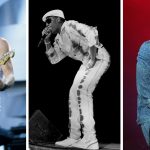The rap music from the 80s was a pivotal era that birthed a new genre of music characterized by fast, rhythmic beats and poetic spoken word lyrics. It revolutionized the music industry with its unique expression of social and cultural issues.
The 80s rap music scene saw the rise of iconic artists like run dmc, public enemy, and n. w. a. , who paved the way for the future of hip-hop. These artists used their music as a platform to address topics such as racism, inequality, and political activism.
They created a powerful voice for the marginalized communities, bringing their struggles to the forefront of popular culture. The impact of 80s rap music can still be felt today, as it continues to inspire and influence artists across various genres.

Credit: pps.innovatureinc.com
The Rise Of Rap Music In The 80S
Rap music emerged as a force to be reckoned with in the 1980s. This revolutionary genre captivated audiences with its unique blend of rhythm, poetry, and social commentary. From the origins of rap music as a genre to influential artists and groups, let’s explore the rise of rap music in the 80s, delving into the social and political context that shaped this cultural phenomenon.
The Origins Of Rap Music As A Genre
- Rap music originated in african american and latino communities in the bronx, new york city, during the 1970s.
- It evolved from the spoken-word traditions of african griots and the lyrical styles of jamaican dub and toasting.
- The use of turntables and mixing techniques by djs played a pivotal role in the early development of rap music.
- The sugarhill gang’s hit song “rapper’s delight” in 1979 brought rap music to the mainstream, reaching a wider audience.
Influential Artists And Groups In The 80S
- Grandmaster flash and the furious five: Known for their groundbreaking single “the message” in 1982, they tackled social and political issues with their poignant lyrics.
- Run-d.m.c. : Their fusion of rock and rap music revolutionized the genre with hits such as “walk this way” featuring aerosmith.
- Public enemy: Renowned for their politically charged lyrics and powerful performances, they highlighted systemic racism and oppression in america.
- N.w.a: This controversial group from los angeles gave a raw and unapologetic portrayal of life in the inner city, influencing generations to come.
- Beastie boys: Crossing over from punk to rap, they brought the genre to a wider audience and showcased its potential for artistic experimentation.
Exploring The Social And Political Context Of Rap Music
- Rap music in the 80s served as a megaphone for marginalized communities, providing a platform to speak out against social injustices.
- Lyrics often addressed issues such as poverty, racial discrimination, police brutality, and the war on drugs.
- Rap music became a means of cultural expression, allowing artists to reflect the realities of urban life and share their experiences.
- This genre challenged societal norms, sparking important conversations about race, class, and identity.
- Despite facing criticism and controversy, rap music in the 80s played a significant role in shaping popular culture and influencing future generations of artists.
The rise of rap music in the 80s marked a turning point in the music industry and cultural landscape. This genre pushed boundaries, gave a voice to the voiceless, and forever changed the face of musical expression. As we delve deeper into the roots of rap music and its 80s pioneers, it’s crucial to recognize the social and political context that made this evolution possible.
Evolution Of Rap Music In The 80S
The Emergence Of Gangsta Rap
In the 1980s, a new and controversial subgenre of rap music emerged, known as gangsta rap. This style of rap music was characterized by its raw and gritty lyrics, which often depicted the harsh realities of inner-city life. Here are the key points to understand about the emergence of gangsta rap:
- Gangsta rap originated on the streets of los angeles, california, where young african-american artists expressed their frustrations and experiences through music.
- The lyrics of gangsta rap often centered around themes of violence, drug dealing, and gang culture, providing a voice for those who felt marginalized and ignored by mainstream society.
- Artists such as n.w.a. (niggaz wit attitudes) and ice-t were at the forefront of the gangsta rap movement, gaining both popularity and controversy for their explicit and politically charged lyrics.
- Gangsta rap was seen as a form of social commentary, shedding a light on the harsh realities faced by many african-americans living in inner-city neighborhoods.
- Despite facing criticism and controversy for its explicit content, gangsta rap quickly gained a dedicated fan base and became a powerful force in shaping the future of rap music.
The Role Of Sampling In Rap Music
Sampling played a crucial role in the evolution of rap music during the 1980s. Here’s what you need to know about the role of sampling in rap:
- Sampling involves taking snippets of existing music and incorporating them into a new song or composition. In rap music, sampling allowed artists to create unique beats and melodies by reimagining and repurposing existing musical elements.
- Sampling became popular in the 80s as artists began to experiment with new ways of creating music. By sampling recognizable and familiar tunes, rap artists could bridge the gap between mainstream and underground music, enticing a broader audience.
- Sampling not only allowed for artistic expression but also served as a form of homage to the pioneers of various music genres, creating a connection between past and present.
- However, sampling also posed legal challenges for rap artists, as they had to navigate copyright laws and obtain permission or pay royalties for using copyrighted material.
- Despite the legal and financial hurdles, sampling became an integral part of rap music, adding depth and texture to songs and contributing to the unique and diverse soundscape of the genre.
Exploring Different Subgenres Of Rap
The 80s marked the development of various subgenres within rap music, each with its own distinct style and influences. Let’s take a look at some of the subgenres that emerged during this era:
- Old school: Old school rap refers to the early years of rap music, primarily in the late 1970s and early 1980s. This subgenre is characterized by its simplistic beats, catchy hooks, and party-focused lyrics. Artists like run-d.m.c., grandmaster flash and the furious five, and ll cool j helped popularize old school rap.
- Electro: Electro rap incorporated electronic music elements such as synthesizers and drum machines, creating a futuristic sound. Artists like afrika bambaataa and the sugarhill gang played a significant role in the rise of electro rap.
- Conscious rap: Conscious rap, also known as political rap, focused on social and political issues. Artists like krs-one and public enemy used their music to address topics such as racism, poverty, and injustice, aiming to raise awareness and spark change.
- Pop rap: As rap music gained mainstream recognition, pop rap emerged as a more commercial and radio-friendly subgenre. Artists like mc hammer, vanilla ice, and salt-n-pepa incorporated catchy melodies, danceable beats, and lighthearted lyrics into their songs.
- Experimental: The 80s also witnessed the rise of experimental rap, where artists pushed the boundaries of traditional rap music. Acts like de la soul and beastie boys incorporated unconventional samples, diverse musical genres, and abstract lyrics, challenging the norms of rap music.
The 80s was undeniably a transformative decade for rap music. The emergence of gangsta rap, the role of sampling, and the exploration of various subgenres all contributed to the rich tapestry of rap music as we know it today.
Cultural Impact Of Rap Music In The 80S
Rap Music As A Tool For Social Commentary
Rap music in the 80s was more than just a genre of music; it served as a powerful tool for social commentary. Here are some key points to consider:
- Rap music emerged as a platform for artists to express their thoughts on social issues, such as racism, poverty, and inequality.
- Through thought-provoking lyrics and vivid storytelling, rap artists shed light on the struggles faced by marginalized communities, giving them a voice and bringing awareness to their experiences.
- The raw and unfiltered nature of rap music allowed for honest and often controversial discussions about societal norms and injustices.
- Artists like grandmaster flash and the furious five’s “the message” and public enemy’s “fight the power” became anthems for social change and inspired a generation of activists.
- Rap music also challenged mainstream values and ideologies, encouraging listeners to question authority, challenge the status quo, and think critically about societal norms.
Rap Music And Fashion Trends In The 80S
The influence of rap music extended beyond the airwaves and into the world of fashion. Here are some key points to consider:
- Rap artists in the 80s were known for their unique sense of style, characterized by vibrant colors, oversized clothing, and flashy accessories.
- Artists like run-d.m.c. Popularized the iconic “adidas tracksuit” look, which became synonymous with hip-hop culture during that era.
- The rise of b-boy and b-girl culture, influenced by rap music, introduced new fashion trends such as breakdancing attire, including parachute pants, kangol hats, and sneakers.
- The fashion choices of rap artists had a significant impact on popular culture, inspiring fashion designers and influencing mainstream fashion trends throughout the decade.
- Rap music’s influence on fashion continued to resonate long after the 80s, shaping the style and aesthetics of subsequent generations and establishing a lasting connection between music and fashion.
The Influence Of Rap Music On Popular Culture
Rap music in the 80s left an indelible mark on popular culture, transcending musical boundaries. Here are some key points to consider:
- Rap music introduced a new form of expression, merging poetry, storytelling, and rhythm over unique beats, captivating audiences worldwide.
- The emergence of music videos and shows like mtv helped expose rap music to a broader audience and contributed to its rise in popularity.
- Rap music not only influenced the music industry but also impacted other forms of art, such as film and literature, with rap-inspired storytelling and themes permeating various creative mediums.
- The 80s saw the birth of hip-hop culture, which encompassed rap music, graffiti art, breakdancing, and djing, creating a multi-faceted movement that influenced youth culture globally.
- Rap music’s influence on popular culture continues to this day, with its influence evident in contemporary music, fashion, and social movements.
Remember, the cultural impact of rap music in the 80s extended far beyond the music itself, serving as a tool for social commentary, shaping fashion trends, and leaving an enduring mark on popular culture.
Technological Advancements In 80S Rap Music
Rap music in the 80s saw significant technological advancements that revolutionized the genre’s production and sound. From the emergence of drum machines and samplers to the introduction of djs and turntablism, the 80s marked a pivotal period in rap music history.
Let’s delve into the role of drum machines and samplers, the evolution of rap music production techniques, and explore the contribution of djs and turntablism.
The Role Of Drum Machines And Samplers
- Drum machines and samplers played a crucial role in shaping the sound of 80s rap music.
- These technological innovations allowed artists to create beats, rhythms, and sounds without the need for live musicians.
- Drum machines such as the roland tr-808 and the linndrum lm-1 became iconic instruments in hip-hop and contributed to the genre’s distinctive sound.
- Samplers allowed rap artists to sample various musical elements, including drum breaks, basslines, and melodies, from existing songs and integrate them into their own compositions.
- The use of drum machines and samplers provided rap artists with newfound creative freedom and enabled the production of innovative and unique tracks.
The Evolution Of Rap Music Production Techniques
- In the 80s, rap music production techniques underwent significant advancements, leading to the birth of new approaches to creating tracks.
- The use of multi-track recording allowed for layering different sounds and instruments, resulting in richer and more complex compositions.
- The integration of synthesizers and digital effects expanded the sonic palette available to producers, adding depth and texture to rap music.
- Artists embraced innovative studio techniques like scratching, looping, and filtering to manipulate sounds and create distinctive sonic signatures.
- Producers experimented with sample manipulation, chopping, and rearranging existing recordings to create entirely new musical compositions.
Exploring The Contribution Of Djs And Turntablism
- Djs and turntablism played an essential role in 80s rap music, both in live performances and studio recordings.
- Djs were the architects of rap music, using turntables to manipulate and mix different records, creating seamless transitions and unique sound collages.
- Turntablism introduced innovative scratching techniques, where djs used the turntable’s needle to create rhythmic patterns and sound effects.
- Djs and turntablism brought a dynamic and interactive element to rap performances, captivating audiences with their skillful manipulation of vinyl records.
- The contribution of djs and turntablism to rap music cannot be overstated, as they not only provided musical accompaniment but became integral members of rap groups and pioneers in their own right.
The technological advancements in rap music during the 80s propelled the genre to new heights. The introduction of drum machines and samplers, the evolution of production techniques, and the influence of djs and turntablism all contributed to the unique sound and style of 80s rap.
These innovations laid the foundation for rap music’s continued growth and influence in subsequent decades.
Notable Albums And Songs From The 80S
The 80s was a transformative period for rap music, birthing a wave of iconic albums and timeless hits that continue to be celebrated today. From the emergence of groundbreaking artists to the evolution of a distinct rap culture, the 80s left an indelible mark on the genre.
In this section, we will explore notable albums and songs from the decade, highlighting their significance and lasting impact.
Iconic Rap Albums Of The 80S
- “straight outta compton” by n.w.a: Considered one of the most influential rap albums of all time, “straight outta compton” introduced gangsta rap to the mainstream. With hard-hitting tracks like “express yourself” and the incendiary title track, n.w.a’s debut album shattered boundaries and sparked significant controversy.
- “licensed to ill” by beastie boys: Released in 1986, this album propelled the beastie boys to superstardom and remains a seminal work in rap history. Blending rap with rock elements, “licensed to ill” featured hits like “fight for your right” and “no sleep till brooklyn,” solidifying the trio’s place in hip-hop lore.
- “raising hell” by run-d.m.c. : With their fusion of rap and rock, run-d.m.c. Revolutionized the genre, and “raising hell” played a crucial role in their success. The album’s standout track, “walk this way,” featuring aerosmith, not only brought rap and rock together but also propelled rap music into the mainstream.
Classic Rap Songs From The Era
- “the message” by grandmaster flash and the furious five: Released in 1982, “the message” is widely regarded as one of the most significant rap songs of all time. Its introspective lyrics shed light on the realities of inner-city life, creating a socially conscious narrative that resonated with audiences and transformed rap into a platform for storytelling.
- “planet rock” by afrika bambaataa & the soulsonic force: A pioneering track in the fusion of rap and electronic music, “planet rock” showcased the futuristic sound that would define the 80s rap scene. With its infectious beats and innovative production, this song became a blueprint for the emerging hip-hop genre.
- “paid in full” by eric b. & rakim: Known for their intricate lyricism and smooth flows, eric b. & rakim brought sophistication to rap music with their album “paid in full.” The title track, with its distinctive beat and rakim’s impeccable wordplay, solidified their status as rap innovators and set the stage for the future of the genre.
Exploring The Legacy Of 80S Rap Music
The music of the 80s laid the foundation for rap as we know it today, influencing artists across generations. Its impact can be seen in various aspects of modern hip-hop culture, from music production to fashion and language. Key elements of the 80s rap legacy include:
- Sampling and production techniques: The 80s saw the rise of sampling, where artists incorporated snippets of existing songs into their tracks. This innovative approach to production not only added depth to rap music but also influenced the development of various music genres.
- Fashion and style: The fashion trends of 80s rap, including track suits, gold chains, and bucket hats, became synonymous with the genre. Today, these retro styles still find their way into contemporary fashion, showcasing the enduring legacy of the 80s rap aesthetic.
- Sociopolitical commentary: Rap music in the 80s became a voice for marginalized communities, shedding light on social and political issues affecting inner-city neighborhoods. Artists used their lyrics to address topics such as racism, poverty, and police brutality, creating a platform for activism and sparking important conversations.
The impact of rap music from the 80s continues to reverberate through the industry, shaping the sound and culture of contemporary hip-hop. These notable albums and songs are a testament to the creativity and innovation that emerged during this transformative era, leaving an enduring legacy that still resonates with fans today.
Frequently Asked Questions Of Rap Music From The 80S
How Did Rap Music Evolve In The 80S?
Rap music in the 80s evolved from the blend of funk, disco, and hip-hop styles. Artists like run-d. m. c. , grandmaster flash, and beastie boys paved the way for this genre by incorporating storytelling and urban experiences into their lyrics.
Who Were The Pioneers Of Rap Music In The 80S?
Pioneers of rap music in the 80s include iconic artists such as run-d. m. c. , grandmaster flash and the furious five, ll cool j, and public enemy. These visionary artists laid the foundation for the genre and influenced future generations of rap musicians.
What Were The Key Characteristics Of Rap Music In The 80S?
The key characteristics of rap music in the 80s were its rhythmic flow, lyrical storytelling, and the use of turntables and samplers. The genre reflected the cultural and social issues of urban life and provided a platform for artists to express their thoughts and experiences.
How Did 80S Rap Music Impact Pop Culture?
80s rap music had a profound impact on pop culture by breaking social barriers and giving a voice to underrepresented communities. It revolutionized music production techniques, fashion trends, and language, shaping the way we perceive and experience music today.
Are There Any Notable Rap Albums From The 80S?
Yes, there are several notable rap albums from the 80s that defined the genre. Including run-d. m. c. ‘s self-titled album, beastie boys’ “licensed to ill,” n. w. a. ‘s “straight outta compton,” and public enemy’s “it takes a nation of millions to hold us back.
” These albums are considered classics and have had a lasting impact on rap music.
Did Rap Music Gain Mainstream Popularity In The 80S?
While rap music gained popularity in the 80s, it didn’t achieve widespread mainstream success until later. However, its influence on pop culture was undeniable, and it laid the groundwork for the commercial success and global recognition that rap music enjoys today.
Conclusion
The rap music from the 80s holds a special place in the history of the genre. Its unique blend of storytelling, social commentary, and rhythmic poetry laid the foundation for the rap music we know today. From the politically charged lyrics of public enemy to the smooth and catchy beats of ll cool j, the 80s saw the emergence of rap icons that shaped the future of music.
Not only did rap music become a platform for marginalized voices to be heard, but it also became an avenue for self-expression and empowerment. The influential impact of 80s rap can still be felt in contemporary music, with many artists drawing inspiration from the pioneers who paved the way.
So, if you’re a fan of rap music or simply interested in exploring its roots, taking a trip back to the 80s is a must. Discover the authenticity, passion, and creativity that defined this revolutionary era in music history.













